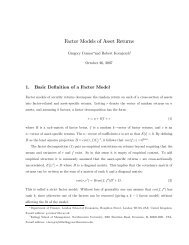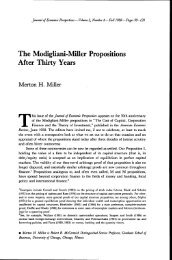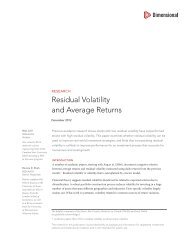Campbell, John Y, Jens Hilscher and Jan Szilagyi, 2005.
Campbell, John Y, Jens Hilscher and Jan Szilagyi, 2005.
Campbell, John Y, Jens Hilscher and Jan Szilagyi, 2005.
You also want an ePaper? Increase the reach of your titles
YUMPU automatically turns print PDFs into web optimized ePapers that Google loves.
1 IntroductionThe concept of financial distress is often invoked in the asset pricing literature toexplain otherwise anomalous patterns in the cross-section of stock returns. Theidea is that certain companies have an elevated risk that they will fail to meet theirfinancial obligations, <strong>and</strong> investors charge a premium for bearing this risk. 2While this idea has a certain plausibility, it leaves a number of basic questionsunanswered. First, how do we measure the failure to meet financial obligations?Second, how do we measure the probability that a firm will fail to meet its financialobligations? Third, even if we have answered these questions <strong>and</strong> thereby constructedan empirical measure of financial distress, is it the case that the stock prices offinancially distressed companies move together in response to a common risk factor?Finally, what returns have financially distressed stocks provided historically? Is thereany evidence that financial distress risk carries a premium?In this paper we consider two alternative ways in which a firm may fail to meet itsfinancial obligations. First, we look at bankruptcy filings under either Chapter 7 orChapter 11 of the bankruptcy code. Second, we look at failures, defined more broadlyto include bankruptcies, delistings, or D (“default”) ratings issued by a leading creditrating agency. The broader definition of failure allows us to capture at least somecases where firms avoid bankruptcy by negotiating with creditors out of court (Gilson,<strong>John</strong>, <strong>and</strong> Lang 1990, Gilson 1997). It also captures firms that perform so poorlythat their stocks are delisted from the exchange, an event which sometimes precedesbankruptcy or formal default.To measure the probability that a firm enters either bankruptcy or failure, weadopt a relatively atheoretical econometric approach. We estimate a dynamic panelmodel using a logit specification, following Shumway (2001), Chava <strong>and</strong> Jarrow(2004), <strong>and</strong> others. We extend the previous literature by considering a wide rangeof explanatory variables, including both accounting <strong>and</strong> equity-market variables, <strong>and</strong>by explicitly considering how the optimal specification varies with the horizon of the2 Chan <strong>and</strong> Chen (1991), for example, attribute the size premium to the prevalence of “marginalfirms” in small-stock portfolios, <strong>and</strong> describe marginal firmsasfollows: “Theyhavelostmarketvalue because of poor performance, they are inefficient producers, <strong>and</strong> they are likely to have highfinancial leverage <strong>and</strong> cash flow problems. They are marginal in the sense that their prices tend tobe more sensitive to changes in the economy, <strong>and</strong> they are less likely to survive adverse economicconditions.” Fama <strong>and</strong> French (1996) use the term “relative distress” in a similar fashion.1





